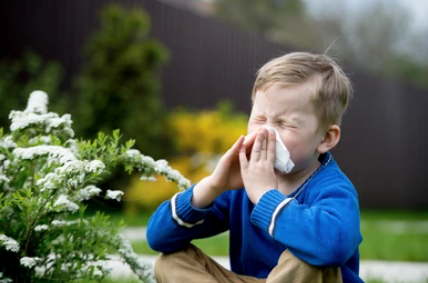Protecting Your Little Ones: The Benefits of Allergy Drops for Kids
Allergies can cause a great deal of discomfort in children, triggering symptoms ranging from mild to severe, from runny noses and itchy eyes to severe allergic reactions like anaphylaxis. Unfortunately, most allergy treatments only provide temporary relief, focusing on the symptoms instead of the allergy.

With allergy immunotherapy, including allergy drops, the focus turns to the root problem: the allergy. The treatment helps reduce your child’s sensitivity to the allergy, allowing them to enjoy blissful relief from the ongoing irritation of allergy symptoms. In this article, we’ll explore allergy drops for your kids and the benefits for their health.
Understanding Allergies in Children
An allergy is the body’s reaction to a foreign substance called an allergen. When your child has an allergy, their body naturally produces antibodies that flag the allergen as harmful even if it isn’t. These antibodies communicate with cells that release chemicals, resulting in allergic symptoms.
Allergy symptoms in children can range in severity, with the most common symptoms including:
* Runny or itchy nose
* Sneezing
* Coughing
* Postnasal drip
* Nasal congestion
* Itchy, watery, and red eyes
* Skin rashes or hives
* Difficulty breathing
* Upset stomach
The symptoms can vary based on the type of allergy. Millions of children throughout the United States suffer from at least one type of allergy. Approximately one in five children have a seasonal allergy, while just under 6% have food allergies, and around 11% have eczema.
These allergies cause discomfort in millions of children, ranging in severity from symptoms as mild as a runny nose to as severe as anaphylaxis. Unfortunately, the most common treatments for these allergies, including antihistamines, corticosteroids, and decongestants, don’t treat the allergy itself. Instead, they treat the symptoms, providing temporary relief from an ongoing problem.
This is where allergy immunotherapy comes in. Allergy immunotherapy (AIT) is designed to focus on the root problem: the allergy.
What Are Allergy Drops?
Allergy drops are a type of sublingual immunotherapy, not to be confused with drops used to treat symptoms of allergies, like allergy eye drops. Unlike medications that treat the symptoms, allergy drops used for immunotherapy steer the attention to the root cause of the allergy.
They focus on relieving the body’s sensitivity to a particular allergen, such as bee venom, pollen, or pet dander. To reduce the body’s reaction to the allergen, the allergy drops help reduce the production of the “blocking” antibody that creates the symptoms. Each dose of the drops contains a small amount of the allergen, which, over time, minimises the body’s reaction.
Allergy Drops vs. Other Types of Immunotherapy
Allergy immunotherapy takes various shapes, including sublingual (under the tongue) and subcutaneous (under the skin). Allergy drops are a type of sublingual immunotherapy (SLIT), as they’re administered by mouth under the tongue. Allergy tablets are another type of sublingual allergy immunotherapy.
Subcutaneous immunotherapy (SCIT) is administered under the skin via an injection. This is the most common type of AIT, although many parents may choose to use SLIT, as some children may not do well with needles or frequent injections.
Both types of AIT employ the same method for addressing the allergy. While sublingual immunotherapy uses drops or tablets under the tongue to administer the allergen, subcutaneous immunotherapy delivers it under the skin using an injectable fluid.
The Benefits of Allergy Drops
Allergy drops can be an excellent way to leverage the benefits of AIT for your child’s health. They’re a solid alternative to allergy shots, offering a unique range of benefits over other methods.
The most prominent benefit is the lack of frequent injections. Many children don’t do well with needles or frequent doctor visits for injections. Since SCIT can require multiple doctor visits per week, allergy drops are an excellent alternative. They can be administered at home and don’t require needles or injections, making them an outstanding option for busy families or children with a fear of needles.
Moreover, allergy drops can be a more cost-effective solution compared to other types of allergy immunotherapy. Since you won’t need to leave the comfort of your home to administer the treatment, the cost of allergy drops can be substantially lower than the cost of regular doctor visits for injections.
Of course, the primary benefit of allergy drops is the long-term relief from allergies. As the drops help desensitise your child’s body and immune system to the allergen, the production of the “blocking” antibody reduces, allowing your child to experience fewer and less severe symptoms over time.
It’s important to note that the timeline for experiencing a reduced allergic response can vary. While most people begin to notice the effects of the treatment within the first year, the best results typically appear during the second and third years. The treatment requires long-term commitment, so it’s important to ensure you’re on board with this factor before beginning treatment.
Closing Thoughts
Allergy drops can be an excellent option for parents who want to invest in a long-term and cost-effective solution for their child’s allergies. These drops can make a significant difference in your child’s symptoms, helping by targeting the root cause of the allergy to reduce your child’s sensitivity to the allergen.
If you’re considering allergy immunotherapy for your child, talk to your healthcare provider about available options to ensure you select the best fit for your child’s needs. Remember, allergy immunotherapy takes time to work, so it’s a long-term commitment!